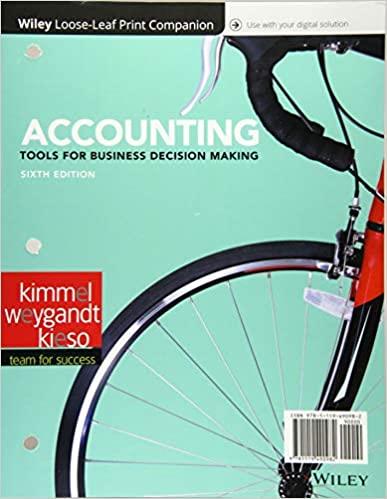Answered step by step
Verified Expert Solution
Question
1 Approved Answer
ECON 1 2 2 - Case Study From a young age, Julie has always loved to bake. Julie went to culinary school to become a
ECON Case Study
From a young age, Julie has always loved to bake. Julie went to culinary school to become a professional
baker and open her own bakery. Although Julie has many skills in the kitchen, she knows nothing about
business, so she decides to take a Managerial Accounting course before opening her bakery. While taking the class, she takes the concepts from each Chapter and relates the material to her bakery to make sure she is fully prepared to get it up and running. Put yourself in Julies shoes to prepare to open your bakery
by the end of the semester!
Follow the prompts below, that align with the content of each chapter, and use Excel to prepare yourself
to get your bakery up and running:
Below is a list of businessrelated expenses Julie is expecng to have in her first year of business:
Bakery Rent
Julies Supervisor Salary
Bakers Wages
Hourly Bakery Cashier
Tax Accountant
Ingredients Sugar Buter, Eggs, Milk, Baking Powder, Flour
Bakery Ulies
Bakery Insurance
Bakery Oven Depreciaon
Business Cards
Cake Boxes
Bakery Refrigerator Depreciaon
Latex Gloves for Bakers
Microso Office Suite Subscripon Excel
Please categorize each cost as Direct vs Indirect, Product DMDLMOH vs Period, and Prime
vs Conversion using the dropdowns in Excel.
Julie does not have enough money to hire a Managerial Accountant, so she must track her
business expenses herself. First think about what type of cosng system would be more
beneficial for Julie. She chooses to use Excel to track all her business transacons To test this
out, she has prepared an esmate of her purchases for the first month of business below. This
will help her have a beter understanding of how to track the flow of her inventory.
a Purchase $ in ingredients Sugar Buter, Eggs, Milk, Baking Powder, Flour and
$ in other suppliesmaterials Cake Boxes, Latex Gloves for Bakers to get started.
b Each wedding cake that will require $ in ingredients, $ for a cake box, and $ in
other suppliesmaterials Julie plans on producing weddings cakes in the first month.
c The wedding cake will take hours to make, and Julie esmates she will pay bakers
$hr Julies salary will be $ for the first month.
d Julie expects the first months ulies to be $ rent to be $ insurance to be
$ and bakery equipment depreciaon to be $
e Julie would like to use a bakerywide rate for manufacturing overhead allocaon using
direct labor hours. She esmates that total Manufacturing Overhead will be $
and direct labor hours will be hours for the year.
f Calculate the total manufacturing cost of the wedding cake by adding together the direct
materials, direct labor, and allocated manufacturing overhead for the job.
g Julie plans to sell wedding cakes for $ each.
h Calculate the cost per cake to find the Cost of Goods Sold for Cakes.
Julie might want to use acvitybased cosng instead of a bakerywide rate for allocang
overhead. If Julie uses the following acvies and esmated costs, how much should she
allocate to the wedding cakes that required direct labor hours, machine hours, and
cake boxes.
Acvity Allocaon Base Overhead Cost
Mixing Direct Labor Hours hrs $
Oven Machine Hours hrs $
Packaging Cake Boxes boxes $
Use Excel to calculate the allocaon rate for each acvity to find the amount of overhead that
should be allocated to the wedding cake.
Look at how the allocated overhead under the acvitybased cosng differs from the bakerywide method used in # and think how this might affect our business.
Julie wants to know if she will be able to sell enough wedding cakes each month to be able to
pay the bills. Use the expenses listed in # and the selling price of cakes in # to categorize the
business costs as Variable or Fixed in Excel.
Aer categorizing the expenses, calculate the esmated number of wedding cakes that Julie will
need to sell to breakeven, assuming she will produce cakes in the first month.
If Julie wants to make a profit of $ how many wedding cakes would she need to sell?
If Julie thinks she is likely to sell cakes, what will her operang income be
Julie is in a perfect compeon market, where she is a pricetaker, which is why she is stuck
selling her cakes for $ each. Using the data from # assuming she is selling cakes per
month, she wants to know how much her total product costs should be if she wants to make a
profit of of the selling price. Are her current product costs allowing her to meet the desired
profit that she has set for herself?
Step by Step Solution
There are 3 Steps involved in it
Step: 1

Get Instant Access to Expert-Tailored Solutions
See step-by-step solutions with expert insights and AI powered tools for academic success
Step: 2

Step: 3

Ace Your Homework with AI
Get the answers you need in no time with our AI-driven, step-by-step assistance
Get Started


